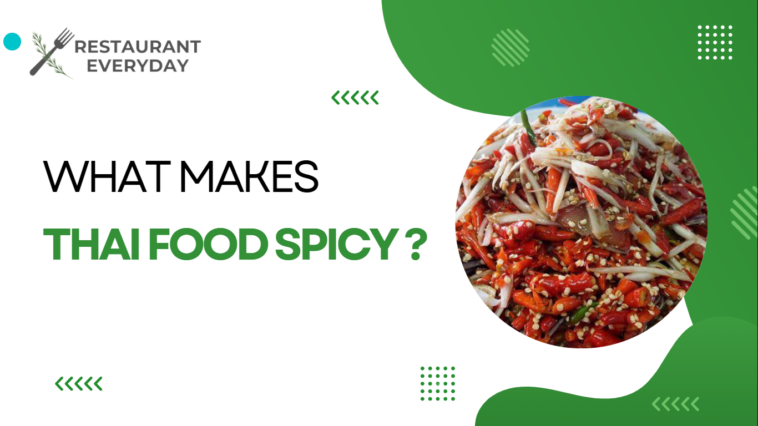Thai cuisine is full of tempting flavors, and at the heart of this culinary tapestry lies the captivating element of spiciness. Thai food enthusiasts often find themselves drawn to the tantalizing heat that permeates dishes, leaving taste buds tingling with excitement. In this exploration, we will delve into the intricacies of what makes Thai food spicy, uncovering the key ingredients, culinary techniques, and regional influences that contribute to this fiery allure.
Why Thai Food is so Spicy?
Thai food’s propensity for spiciness is deeply rooted in the country’s culinary tradition. In Thai culture, the use of spices, particularly chili peppers, is considered an integral aspect of achieving a well-balanced and flavorful dish. Spiciness is not merely a sensation but a fundamental element that contributes to the overall enjoyment of Thai cuisine, reflecting the Thai people’s appreciation for a diverse range of tastes.
The availability and diversity of chili peppers in Thailand also play a crucial role in the spiciness of Thai dishes. The country is home to a number of chili varieties, from mildly pungent to extremely hot. The ubiquitous use of Thai Bird’s Eye Chili, known for its small size and intense heat, exemplifies the significance of chili peppers in enhancing the depth and complexity of flavors in Thai cooking. The combination of cultural tradition and the abundance of spicy ingredients creates a culinary landscape where spiciness is celebrated and embraced as an essential part of the Thai gastronomic experience.
Key Ingredients for Spiciness in Thai Food
Chili Peppers
At the core of Thai spiciness are chili peppers, which come in a myriad of varieties, each contributing its unique flavor profile and heat level. Thai cuisine commonly features chili peppers that range from moderately spicy to extremely hot, with the Scoville scale serving as a measure of their intensity.
Curry Paste
Central to Thai spiciness is the use of curry paste, a flavorful blend of ingredients that includes chili peppers, garlic, lemongrass, and various spices. The paste not only provides heat but also imparts complex layers of taste to Thai dishes. Different regions and recipes offer variations in spice levels, allowing for a diverse range of spicy culinary experiences.
Nam Prik
Another cornerstone of Thai spiciness is Nam Prik, a traditional chili paste that varies across regions and households. Comprising a mix of chilies, garlic, and other ingredients, Nam Prik is used as a condiment or a base for creating spicy dips and sauces. Its role in Thai cuisine showcases the creativity and versatility of spicing up meals.
Fresh Herbs and Spices
To balance the heat, Thai cuisine incorporates an array of fresh herbs and spices like cilantro, basil, and mint. These elements not only add complexity to the flavor but also provide a refreshing contrast, enhancing the overall dining experience.
Lime and Citrus
The addition of lime and citrus plays a crucial role in Thai cuisine, offering a citrusy dimension that complements the spiciness. This pairing creates a harmonious balance, with the acidity cutting through the heat and elevating the dish to new heights.
Related: Is Thai Food Gluten-Free?
Culinary Techniques used to make spicy Thai food
Stir-frying
Thai chefs often employ stir-frying at high temperatures to quickly cook ingredients, enhancing the Maillard reaction that intensifies flavors and spiciness. This technique not only infuses heat into the dish but also imparts a smoky depth, making each bite a sensory delight.
Roasting and Grilling
Roasting and grilling are techniques that bring out the bold and charred flavors in Thai cuisine, intensifying the spiciness of certain dishes. Popular spicy grilled options, such as Gai Yang (grilled chicken) or Pla Pao (salt-crusted grilled fish), showcase the mastery of combining heat with distinctive smoky undertones. If you are in Houston and want to experience these delicacies visit the famous Nidda Thai Cuisine.
What Health Benefits does Spicy Thai Food Have?
Metabolism Boost : Spicy Thai food often contains capsaicin, a compound found in chili peppers that may temporarily boost metabolism. This can contribute to calorie burning and support weight management.
Anti-Inflammatory Properties : Many spices used in Thai cuisine, such as turmeric, ginger, and garlic, have anti-inflammatory properties. Regular consumption may help reduce inflammation in the body, benefiting joint and cardiovascular health.
Rich in Antioxidants: Herbs and spices like basil, coriander, and turmeric in Thai dishes are rich in antioxidants. These compounds combat oxidative stress, potentially lowering the risk of chronic diseases and promoting overall well-being.
Heart Health: Capsaicin in chili peppers has been associated with cardiovascular benefits, including lower blood pressure and improved cholesterol levels. Garlic, commonly used in Thai cuisine, may also contribute to heart health.
Boosted Immunity:Ingredients like garlic and ginger in Thai dishes possess antimicrobial properties that may support the immune system, aiding the body’s defense against infections and illnesses.
Improved Digestion: Thai cuisine often includes digestion-friendly spices like ginger and lemongrass, which can alleviate digestive issues, reduce bloating, and promote a healthy gut.
Mood Enhancement: Spicy foods, including those with chili peppers, can stimulate the release of endorphins, contributing to an improved mood and overall sense of well-being.
Pain Relief: While not directly related to consuming spicy Thai food, capsaicin found in chili peppers has been used topically for pain relief, showcasing its potential analgesic properties.
Regional Influences on Thai Food’s Spiciness
Northern Thai Cuisine
In the northern regions of Thailand, unique spices and herbs take center stage in creating dishes that are both spicy and distinctive. Signature dishes like Khao Soi, a spicy coconut curry soup, showcase the rich culinary tapestry of Northern Thai cuisine.
Southern Thai Cuisine
The southern part of Thailand, with its coastal influence, brings a bounty of seafood and intense spices to the table. Spicy curries, such as Gaeng Tai Pla (southern Thai fish kidney curry), highlight the bold and fiery flavors that characterize this region’s culinary offerings. Bangkok 96 street food restaurant would serve you the exact tastes of southern Thailand while being in Detroit.
Cultural Significance of Spices in Thai Food
The concept of “aroy,” meaning deliciousness in Thai culture, emphasizes the importance of a well-balanced and flavorful meal. Spiciness is not merely a sensation but an integral part of creating a dish that is truly aroy. Additionally, the social aspects of consuming spicy food in Thai gatherings underscore its significance in fostering communal connections.
Is all Thai Food spicy?
While Thai cuisine is often associated with spiciness, not all Thai food is inherently spicy. Thai culinary tradition is characterized by a balance of flavors, including sweet, sour, salty, bitter, and spicy. Many Thai dishes do incorporate heat, but the level of spiciness can vary widely, and not every dish is intensely spicy.
Some Thai dishes are mild or have a subtle hint of spice, catering to a range of preferences. For example, dishes like Pad Thai (stir-fried noodles), Tom Kha Gai (coconut milk soup), or Green Curry can be adjusted in terms of spiciness based on individual taste preferences.
In Thai restaurants, it’s common for customers to specify their desired spice level when ordering. The spiciness can be customized, allowing individuals to enjoy the richness of Thai flavors without the intense heat.
Overall, while spice is a significant element in Thai cuisine, there is a diversity of dishes that cater to varying heat preferences, making Thai food accessible to a broad audience with different taste preferences.
Conclusion: What Makes Thai Food Spicy?
In conclusion, Thai cuisine’s spiciness is a multi-faceted symphony of flavors, where chili peppers, spice blends, culinary techniques, and regional influences harmonize to create an unforgettable culinary experience. It’s essential to consume spicy foods in moderation, as individual responses may vary. Individuals with specific medical conditions or sensitivities should consult with a healthcare professional before making significant changes to their diet.The diverse and rich nature of Thai spiciness reflects the creativity and passion embedded in the country’s culinary heritage, inviting food enthusiasts to embark on a journey of bold and fiery delights.
People may also like to read: Why Are Chinese Restaurants Closed on Mondays




